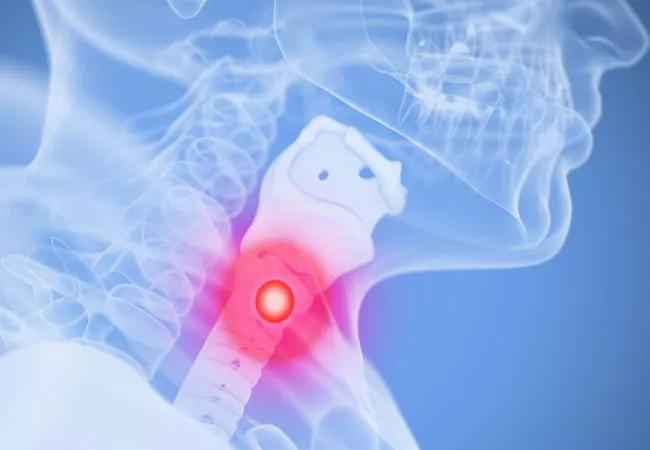Why we continue to provide the same standard radiation treatment for both HPV-OPC and non-HPV-OPC

Primary surgical resection or definitive radiation therapy (RT) are both viable treatment options for oropharyngeal cancer (OPC). Chemotherapy is added to either definitive RT (in the absence of surgery) or combined with RT in the adjuvant setting (following resection in the presence of high risk pathologic features).
Cleveland Clinic is a non-profit academic medical center. Advertising on our site helps support our mission. We do not endorse non-Cleveland Clinic products or services. Policy
“In advanced disease (higher tumor stage, nodal disease), concurrent chemotherapy/RT can be used in absence of resection,” states Jessica Geiger, MD, an oncologist with Cleveland Clinic Cancer Center. “This is the favored approach at our institution if the patient is deemed a candidate for concurrent therapy.”
These treatments are very difficult on patients, with 80% developing acute treatment-related effects such as mucositis, dysphagia and odynophagia. The addition of chemotherapy to this treatment regimen adds to the burden of treatment-related effects.
There are two distinct forms of OPC. The first occurs in patients at high risk for the disease given their long-time smoking and drinking habits. The second is related to the human papillomavirus (HPV) and typically occurs in younger patients who are light (< 10 pack years) or never smokers. HPV-related OPC tends to respond more favorably to treatment, and overall these patients have a better prognosis.
Three-year progression-free survival reported for HPV-related OPC (HPV-OPC) is about 75%-82%, compared to 45%-57% for HPV-negative OPC. This difference has led to an updated staging system to better reflect the differences in prognosis, but without a respective shift in treatment regimens.
If patients with HPV-OPC are younger and have better outcomes, do they really need the same intensity of treatment as the non-HPV-related OPC patients? Given the absence of clear guidelines for treatment deintensification, this was the focus of a review published recently by Dr. Geiger and her surgical oncology colleague from the Cleveland Clinic Head and Neck Institute, Jamie Ku, MD.
The concept of deintensifying therapy refers to the search for a sweet spot at which treatment is effective with the least amount of adverse effects. Deintensification strategies might include less invasive surgery, the reduction or omission of adjuvant RT, or the omission of chemotherapy.
“Often, cancers of the oropharynx are in locations that are difficult to reach surgically,” says Dr. Ku. “Because accessing these cancers can be challenging, traditional surgeries are maximally invasive and associated with high morbidity, complication rates, and poor functional outcomes.”
Transoral robotic surgery (TORS) has emerged as a way to avoid many of the more morbid surgical procedures, when indicated. TORS approach gives surgical oncologists great access to hard-to-reach areas with tremendous 3-dimensional, high definition visualization of the tumor-host interface to allow optimal oncologic resection with faster postoperative recovery and improved functional outcomes.
With TORS, there is no splitting of the lip or jaw nor a neck incision; the surgery is done through the mouth. The procedure takes approximately two to three hours. With good pain control, patients are discharged home within two to three days, and many leave without a feeding tube. A surgical airway or tracheostomy is rarely indicated.
“We find patient selection is key when it comes to surgical deintensification,” Dr. Ku notes. Factors that should be considered include technical feasibility (based on tumor and patient-related factors), anticipated functional outcomes, extent of and necessary treatment of nodal disease, and likely need for adjuvant therapy. Ideally, patients undergoing upfront TORS will avoid all adjuvant therapy or at least adjuvant chemotherapy.
In terms of deintensifying definitive concurrent therapy, we currently find no evidence that deviation from the standard of care (high-dose cisplatin plus RT) is appropriate. One randomized, multi-center trial (RTOG 1016) of RT plus cisplatin compared to RT plus cetuximab (the deintensification arm) found that cetuximab failed to meet non-inferiority criteria. Although studies like this may be disappointing, they confirm the excellent disease control and survival achieved through the current treatment standards.
Researchers continue to seek successful deintensification strategies. There are several trials that are either currently accruing or have just completed accrual, and we eagerly await their results.
The largest one, ECOG 3311, has finished accruing, and uses TORS to evaluate pathologic risk prior to adjuvant therapy. Patients with low risk are observed following resection. Patients at high risk receive the standard of care, concurrent chemotherapy/RT. Patients at intermediate risk are randomized into two groups, receiving either 50 or 60 Gy of adjuvant RT alone. Similar studies, looking at risk-stratification for deintensifying RT, are still accruing, including the SIRS trial (NCT02072148) and the PATHOS trial (NCT02215265).
“Right now, however, we see no role for deviating from the current standards of adjuvant care outside the context of a clinical trial,” states Dr. Geiger. “At Cleveland Clinic, our focus is on providing excellent, multidisciplinary supportive care to all our OPC patients, including nutrition, speech and language therapies, to help minimize the long-term effects of potential adverse events.”

An underdiagnosed condition in patients with cancer

Study demonstrates superior visualization of occult primary lesions

New device offers greater tumor control for malignant liver lesions

Cleveland Clinic researchers discover what drives – and what may halt – virus-induced cancer

First-ever U.S. population-level retrospective analysis reveals many patients with systemic mastocytosis need faster intervention

New program provides prehabilitation and rehabilitation services to help patients with cancer maintain and regain function

First-of-its-kind research investigates the viability of standard screening to reduce the burden of late-stage cancer diagnoses

Global R&D efforts expanding first-line and relapse therapy options for patients